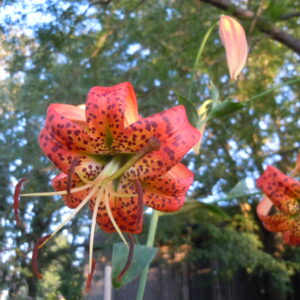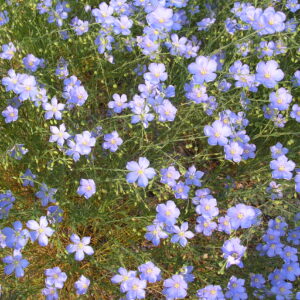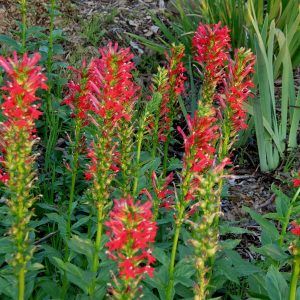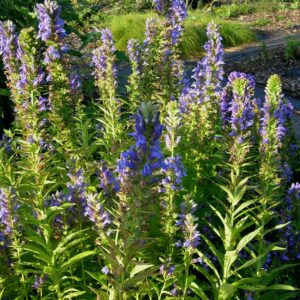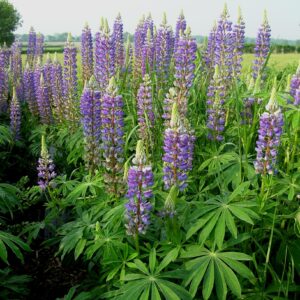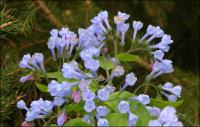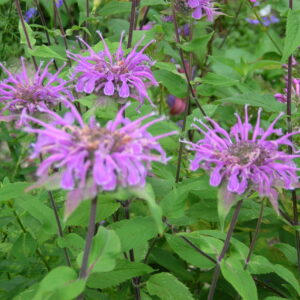Wisconsin Native
Showing 65–72 of 108 results
-
Lilium superbum Meadow lily Z 4-8
Briliant orange with purple spots, turks-cap type lily blooming in late summer to early fall
OUT OF STOCK
Briliant orange with purple spots, turks-cap type lily blooming in late summer to early fall
Size: 10’ x 12”
Care: shade to sun in moist, acidic soil
Native: from VT to Fl & west to Mississippi River, incl. WisconsinLilium was named for the Greek word for smooth, polished referring to its leaves. Collected before 1762. Sold in America’s 1st plant catalog, Bartram’s Broadside, 1783. L.H. Bailey (1913): “The most magnificent and showy of native North American species, well worthy of extensive cultivation.” Found growing in moist meadows from Massachusetts to Indiana and Alabama. In 1665 John Rea called it the “Virginia Martagon,” In 1738 colonial botanist John Bartram sent it to his “brothers of the spade” in London where it caused a sensation. A challenge to grow, it demands well-drained, acid soil and plenty of moisture.
-
Linum perenne ‘Lewisii’ Perennial flax, Prairie flax Z 4-8
Sky blue flowers closing by afternoon all summer
Sky blue flowers closing by afternoon all summer
Size: 24" x 12"
Care: Full sun in well-drained soil.
Native: Wisconsin west and southLinum is Greek for “flax,”, a different species grown for centuries as the source of linen cloth. This variety was named for Meriwether Lewis who found this plant on July 9, 1806 near Great Falls, Montana. Western Natives used the seeds in cooking; Navajo for heartburn; Okanagon as a shampoo; Sioux ate the leaves to cure poor circulation, fever, cramps. They added it to a mixture for smoking.
-
Lobelia cardinalis Cardinal flower Z 3-9
Ruby, cardinal red tubes with an upper lip split in half and a lower lip like a pixie’s apron encircle the spike up and down from August to October beckon hummingbirds to feed.
Ruby, cardinal red tubes with an upper lip split in half and a lower lip like a pixie’s apron encircle the spike up and down from August to October beckon hummingbirds to feed.
Size: 3’ x 12”
Care: sun to part shade in fertile, moist soil. Moist soil important
Native: Canada to Texas, Wisconsin native.
Wildlife Value: attracts hummingbirds
Awards: Received England’s Royal Horticultural Society Award of Merit & Missouri Botanic Garden Plant of Merit.Lobelia is named for Matthias L’Obel (1538-1616) French expatriate who immigrated to England and became physician to King James I. Cherokee cured stomach aches, worms, pain, fever, nose bleeds, rheumatism, headaches, colds and croup with Lobelia. They used the root to treat syphilis. In 1749 Swedish botanist Peter Kalm wrote that Indians used five species of Lobelia to cure venereal disease, “an infallible art of curing it.” Other Natives and colonists used the plant to induce vomiting. At the end of a funeral, Meskwaki Indians threw the dried and pulverized plant into the grave. Meskwaki also chopped the roots and secretly put it in the food of “a quarrelsome pair.” Allegedly “this makes the pair love each other again.” Tradescant the Younger (1608-1662) introduced this to European gardens when he sent it to England in 1637. Offered for sale in Bartram Garden’s 1783 Broadside. Grown by Washington at Mount Vernon and Thomas Jefferson at Monticello. Pressed specimen in Emily Dickinson’s herbarium.
-
Lobelia siphilitica Great lobelia Z 4-9
A striking, erect spike of sky to blueberry-blue blossoms. On top club-shaped buds, below trumpet-shaped, open flowers, made of a tube flaring open with the bottom divided into three, each segment pointed at the ends. From late summer to early fall.
A striking, erect spike of sky to blueberry-blue blossoms. On top club-shaped buds, below trumpet-shaped, open flowers, made of a tube flaring open with the bottom divided into three, each segment pointed at the ends. From late summer to early fall.
Size: 3' x 12"
Care: Full sun to part shade in moist to moist well-drained soil
Native: Connecticut to Wyoming, south to Texas then east to Georgia and all states in between, Wisconsin native.
Wildlife Value: attracts bumble bees, hummingbirds and some butterfliesLobelia is named for Matthias L’Obel (1538-1616) a French expatriate who emigrated to England and became physician to English King James I. Oneidas considered this good medicine for distemper. Sioux treated bloat, diarrhea and dysentery as well as a love charm by adding powdered root to the food of the intended. Cherokee used the root to treat headaches, stomachaches, worms, nosebleeds, colds and syphilis. 1st collected by Rev. John Banister (1649-1692) who moved to colonial Virginia in 1678. A gunman mistakenly shot and killed him while he collected plants. In 1749 Swedish botanist Peter Kalm wrote that Natives used five species of Lobelia to cure venereal disease, having “an infallible art of curing it.” According to John Bartram (1699-17760) “The learned Pehr Kalm (who gained the Knowledge of it from Colonel Johnson, who learned it of the Indians, who, after great Rewards bestowed on several of them, revealed the Secret to him) saith, That the Roots of this Plant cureth the Pox much more perfectly and easily than any mercurial Preparations, and is generally used by the Canada Indians, for the Cure of themselves.” (Better than mercury!) Offered for sale in Bartram Garden’s 1783 Broadside, America’s 1st plant catalog.
-
Lupinus perennis Sun-dial lupin, Old maid’s bonnet, wild pea Z. 4-9
Many flowered blue, pea flowered raceme May-June
Many flowered blue, pea flowered raceme May-June
Size: 1-2' x 12"
Care: full sun in well drained soil. A legume, so it enriches the soil by adding nitrogen.
Native: Maine to FL, Ontario to MN to Louisiana, Wisconsin native.
Wildlife Value: Attracts both hummingbirds and butterflies. The only food for larvae of endangered species, Karner Blue butterfly.Lupinus is Latin from Lupus meaning “wolf.” Cherokee used this to stop bleeding. The Menominee fattened their horses with this Lupin and made them spirited. They rubbed the plant on themselves to give power to control the horses. Likely sent from its native Virginia to England by Tradescant the Younger in 1637. Collected by André Michaux(1746-1802) in late 1700’s. Grown by Jefferson. Grown at America’s 1st botanic garden, Elgin Botanic Garden 1811.
-
Mertensia virginica Virginia bluebells Z 3-7
Clusters of pink buds turn to sky blue trumpets in May. Ephemeral, disappearing in summer to return next spring.
Available for purchase in Spring only
Clusters of pink buds turn to sky blue trumpets in May. Ephemeral, disappearing in summer to return next spring.
Size: 18" x 10" spreads slowly
Care: Moist well-drained soil in part shade.
Native: N.Y. to Tennessee, west to Kansas, Wisconsin native
Wildlife Value: Provides nectar and pollen to honeybees, bumble and mason bees, as well as Skipper butterflies and Sphynx moths. Deer resistant.
Awards: Royal Horticultural Society Award of Merit.
Size: Cherokee cured whooping cough and consumption with Virginia bluebells. Other Natives treated whooping cough, venereal disease, and plain poor health with this.First collected by Rev. Banister (1649-1692) in colonial Virginia C. 1690. Named Mertensia after Franz Karl Mertens (1764-1831), a German botanist who never set foot in America. Grown by both Washington and Jefferson.
-
Monarda fistulosa Wild bergamont Z 3-9
Whorls of hooded lavender tubes in July - August
Whorls of hooded lavender tubes in July – August
Size: 3-4' x 2' spreading
Care: Sun to part shade any soil.
Native: central U.S., Wisconsin native
Wildlife Value: Checkered white, Tiger swallowtail, Giant swallowtail and Melissa blue butterflies relish Wild bergamot’s nectar. Supports over 70 bee species including Rusty patched Bumble Bee.Used medicinally by many Native tribes- Blackfoot, Cherokee, Chippewa, Choctaw, Crow, Dakota and Flathead. Cherokee: to cure colic, flatulence, nosebleed, measles, flu, hysteria and insomnia. Blackfoot called it “Single-young-Man.” Teton Dakotas boiled the leaves and flowers to cure abdominal pain. Ho-Chunk boiled the leaves to remove pimples. Choctaws cured chest pain in children. The Flathead cured colds and sore teeth with Wild Bergamot. HoChunk inhaled fumes in a sweat bath to cure colds. Oneidas made a tea. For the Sioux it was nourishment and a panacea: tea, stomach ache, fever, indigestion, sore throats, fainting, whooping cough, wounds, sore eyes, ulcers, and snakebites. First documented by French explorers before 1635. Plant exported to Europe by Tradescant the Younger in 1637. Grown by Washington at Mount Vernon. Today it is a flavor in Earl Grey tea.
-
Parthenium integrifolium Wild Quinine Z 3-8
Frosty white blooms from July to September
Frosty white blooms from July to October, not especially showy but so reliable and sturdy, excellent. It’s a work horse.
Size: 2-4' x 18"
Care: Full sun in moist well-drained to well-drained soil. Drought tolerant.
Native: Mass. to Georgia, west Minnesota to Arkansas, Wisconsin nativeSeeds fragrant when crushed. Named Quinine because it was used to treat fevers similar to malaria. Catawabe Indians used leaves to treat burns and flowers to treat fever.

